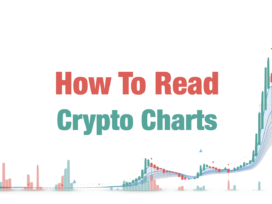
Break Down the Basics of Reading Crypto Charts
Cryptocurrency charts are powerful tools that provide insights into the price movements of various cryptocurrencies. Whether you’re a seasoned trader or a newcomer to the world of cryptocurrencies, understanding how to read these charts is essential. In this guide, we will break down the basics of reading crypto charts, from deciphering different chart types to interpreting essential indicators.
Table of Contents
Types of Crypto Charts
Crypto charts come in different types, each offering a unique perspective on price movements:
Line Charts
Line charts are the simplest form of crypto charts. They depict the closing prices of a cryptocurrency over a specific period. Line charts are great for spotting overall trends and identifying basic support and resistance levels.

Candlestick Charts
Candlestick charts are widely used in the crypto world. Each candlestick represents a specific time frame and includes four key data points: opening price, closing price, highest price (high), and lowest price (low). Candlestick patterns provide insights into price fluctuations, making them valuable for predicting potential market reversals.
Bar Charts
Similar to candlestick charts, bar charts show the same data points but in a different visual format. They consist of vertical lines (bars) with horizontal lines extending to the left and right. Bar charts offer information about price ranges and trends over a given period.
Key Elements on Crypto Charts
Understanding the components of crypto charts is crucial for making informed decisions:
Support and Resistance Levels
Support levels are price points where a cryptocurrency tends to stop falling and might reverse, while resistance levels are where it tends to stop rising. Identifying these levels helps traders determine entry and exit points.
Moving Averages
Moving averages smooth out price data over a specific period, revealing the underlying trend. The 50-day and 200-day moving averages are commonly used to identify long-term trends and potential crossovers.
Relative Strength Index (RSI)
RSI measures the speed and change of price movements. It ranges from 0 to 100 and helps traders assess whether a cryptocurrency is overbought or oversold.
Interpreting Crypto Charts
Crypto charts display price & volume data over time to analyze trends & make trading decisions.
Trends and Patterns
By analyzing price movements, traders can identify trends (uptrend, downtrend, or sideways movement) and patterns (such as triangles, head and shoulders, and flags) that indicate potential future price movements.
Volume Analysis
Volume reflects the number of cryptocurrency units traded during a specific period. High volume often accompanies significant price movements, indicating strong market sentiment.
Conclusion
Reading crypto charts is a skill that takes time and practice to master. By understanding the different chart types, key elements, and indicators, you’ll be better equipped to make informed trading decisions. Remember that while charts provide valuable insights, combining chart analysis with fundamental research is essential for successful cryptocurrency trading.
By following this comprehensive guide, you’ll be well on your way to becoming a proficient chart reader in the exciting world of cryptocurrencies.
FAQs on Reading Crypto Charts
Here are some frequently asked questions about reading crypto charts:
FAQ 1: Why are candlestick charts so popular in crypto trading?
Candlestick charts provide a visual representation of price movements and patterns, making it easier for traders to analyze and predict market trends.
FAQ 2: How can I identify a bullish or bearish trend on a chart?
A bullish trend is characterized by higher highs and higher lows, while a bearish trend has lower highs and lower lows. Identifying these patterns helps you gauge the overall market sentiment.
FAQ 3: Are there any free tools for analyzing crypto charts?
Yes, there are several free charting platforms like TradingView and CoinGecko that offer a wide range of technical indicators and drawing tools.








